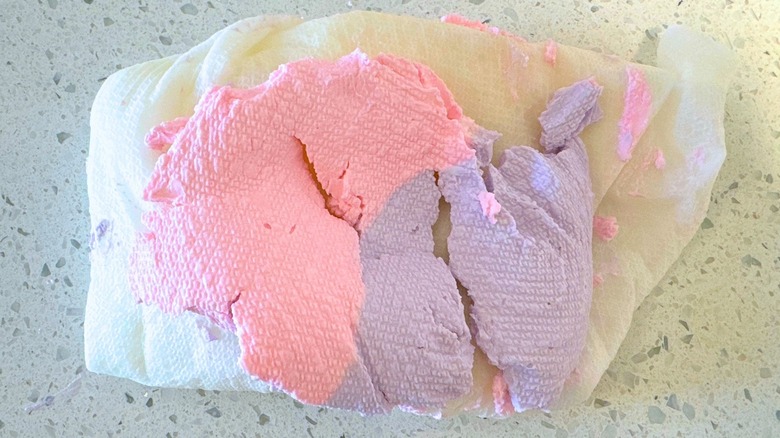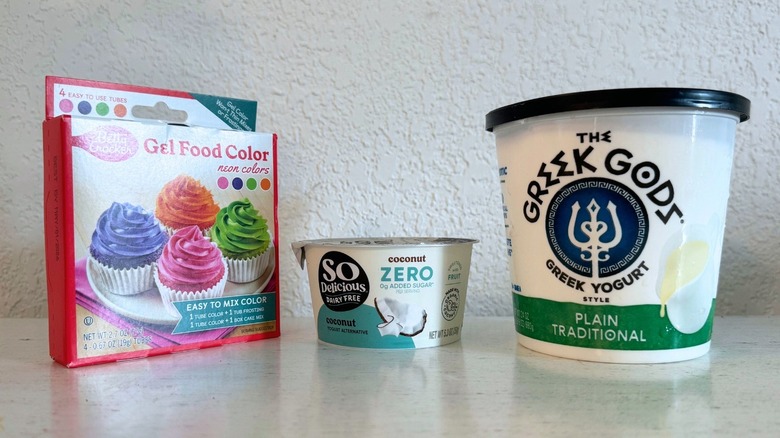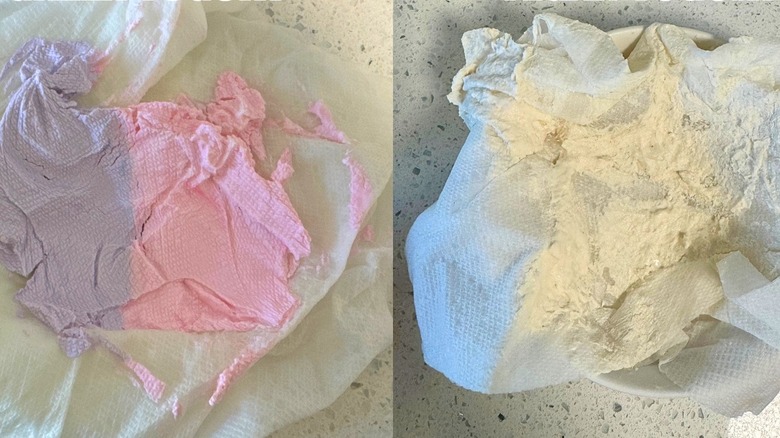Review: TikTok's Dry Yogurt Trend Isn't Really Worth The Effort
Dry yogurt has taken TikTok by storm, with countless videos showcasing hardened, almost clay-like yogurt that supposedly transforms with just a bit of patience and some paper towels. A texture somewhere between butter and cream cheese with that delicious yogurt flavor? Obviously, I had to give it a try. The trend promises a firmer yogurt without any complicated techniques — all you need is a couple of days in the fridge.
This idea draws inspiration from labneh, a Middle Eastern yogurt spread made by straining yogurt to remove excess liquid. A bit of salt is added to the yogurt before it's hung in cheesecloth over a bowl in the fridge, allowing it to thicken slowly as the liquid drains out. Once firm, labneh is served as a dip, drizzled with olive oil or honey, and garnished with herbs, spices, or nuts. Often eaten with pita bread and vegetables like air-fried brussels sprouts, it's a tasty appetizer or snack.
While labneh is typically creamy white and leans on the savory side, dry yogurt on TikTok is all about color and sweetness. People often add food coloring, transforming it into edible artwork with creative toppings like candy bars, frozen fruit, and other aesthetically pleasing ingredients. Skeptical but curious how well this simple paper towel method really works, I set out to try it with both Greek yogurt and a vegan alternative.
My semi-successful attempt at making dry yogurt
For my dry yogurt experiment, I tried both Greek yogurt and a coconut-based vegan yogurt to see how each would turn out. Greek yogurt is a popular choice for this trend, likely because it's already strained; giving it a thicker texture and making it easier to reach that dry, dense consistency. I hadn't seen anyone try vegan yogurt, so I threw it in there to test.
Following the basic setup from TikTok, I placed the yogurt in a bowl lined with paper towels, added a bit of weight (another bowl) to help press out the moisture, and let it sit in the fridge for 48 hours. For fun, I mixed pink and purple food dye into the Greek yogurt to give it that colorful, TikTok-worthy look, while leaving the vegan yogurt plain as a control.
After the full 48 hours, I checked my results. The Greek yogurt had definitely firmed up — thick enough to stay in one piece and far less watery than before, but it lacked that almost buttery consistency I'd envisioned. In some TikTok videos, I'd even heard a satisfying cracking sound under the spoon from the dryness, but mine was still too mushy for that. The vegan yogurt turned out even less successful; it had a clumpy, cottage cheese-like texture rather than being a smooth, cohesive spread. Although it was slightly thicker, it didn't achieve the texture I'd hoped for. If you're considering trying this experiment yourself, I have a few tips to help improve the results.
Tips for better dry yogurt results
Trying the dry yogurt trend is worth it if you're up for a fun experiment and curious about the unique texture it creates. While I found myself missing the usual water content, the creamy, almost buttery mouthfeel was an interesting twist on the typical yogurt experience. Looking back, I made a few mistakes that impacted my results. I purchased a small, individual serving of coconut yogurt and ended up eating half of it before starting the experiment, which left me with too little yogurt to work with. For a better outcome, start with a large tub of whatever fancy yogurt brand you choose to ensure you achieve a cohesive, firm consistency.
I also didn't use a strainer. This resulted in less whey (the water from the yogurt) being removed, causing the excess liquid to soak into the paper towels instead of draining properly, leaving the yogurt not as dry as it could have been. As for the color dye, I did mix it correctly, but I want to emphasize this for others, as I've seen some mention they didn't do it right. Be sure to mix the dye in a separate bowl before incorporating it into the yogurt. Also, don't cut the waiting time short — give it the full 48 hours (or even longer) for the best results. While I personally may stick to regular yogurt in the future, this was an entertaining experiment to try once — just maybe not worth the effort for breakfast every morning.


